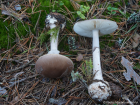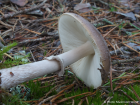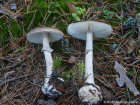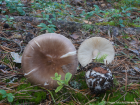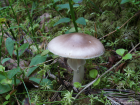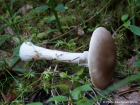Cap hemispherical when young, then convex and finally flattening, greyish brown to brown in colour, darker in the centre and often appearing to be radially lined with purplish-brown fibres. Usually smooth, sometimes with grey patches. The flesh is white with a smell of radish. Gills soft, crowded, white and free from the stem. Stem tapers towards the apex and is whitish, with fine striations above the ring. As the fruit body matures, violaceous grey-brown longitudinal fibres become increasingly evident below the ring. A superior persistent white ring is present, but it soon collapses against the surface of the stem. The volva is made up of short, irregular whitish plaques on the bulbous stem base. Spore print white.
Microscopic Features: The spores are globose or sub-globose in shape, occasionally broadly ellipsoidal. They measure 7.2-9 µm in length and 7.8-11 µm in width. They are amyloid.
Amanita porphyria on the First Nature Web site.
Amanita porphyria on the MushroomExpert.Com Web site.
Many mushrooms are poisonous, and some can be lethally toxic. Distinguishing between edible and poisonous mushrooms can be very challenging. Therefore, we strongly advise against consuming wild mushrooms. This website does not contain any information about the edibility or toxicity of mushrooms.
Although efforts have been made to ensure accuracy on this website, the information may contain errors and omissions. Therefore, all content provided is for educational and informational purposes only and should not be relied upon or used as a basis for consuming any plants or mushrooms.
External links are provided for reference only. We do not endorse or take responsibility for the content, advice, or products found on these sites or in any advertisements shown on this website.
